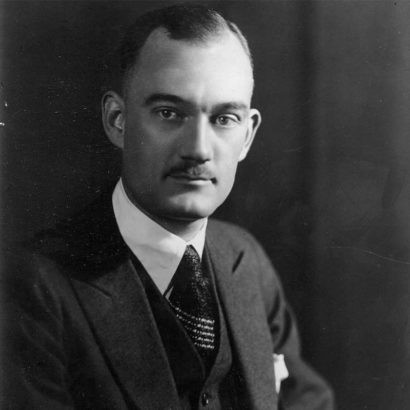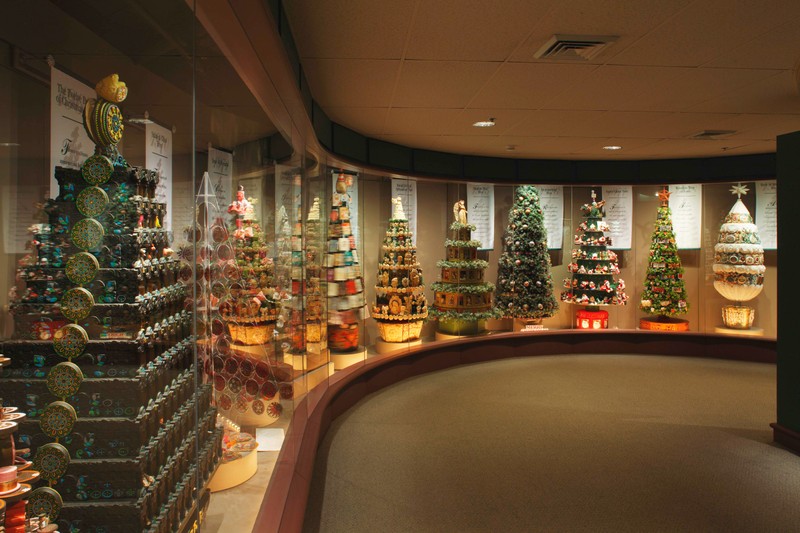Hallmark Visitors Center
Introduction
Author-Uploaded Audio
00:00 / 00:00
Hallmark Corporate Archivist and Historian Samantha Bradbeer introduces herself and discusses the Hallmark Visitors Center.
Text-to-speech Audio
One of the most-visited landmarks of Crown Center, a mixed-use shopping and entertainment center built in the 1960s to be home to Hallmark’s corporate headquarters, this visitor's center offers exhibits and guided tours that explore the history of the Hallmark company. Exhibits and a free tour begin with the arrival of a young Joyce C. Hall (better known as J.C. Hall) in Kansas City and how his often challenging experiences selling postcards and other items designed by others inspired him to purchase a press and start his own company. Together with his older brothers William and Rollie Hall, Hall Brothers (later known as Hallmark) grew into the company known today. Highlights of the experience include the J.C. Hall Christmas Trees, the Bow Machine, the history of Crayola, and Hallmark Media. While the company is known most commonly for its greeting cards, Hallmark has launched several different business ventures which began with J.C. Hall’s interest in advertising and would later include the local department store Halls. When the company began advertising on the radio and in publications like Ladies Home Journal, the Hallmark brand became the biggest name in the greeting card industry. This growth led to requests to sponsor a variety of events such as the first opera created to be broadcast on television by NBC in 1951. The success of that opera led Hallmark to create the Hallmark Hall of Fame and support additional productions leading to the Hallmark Christmas movies that continue to the present.
Images
Hallmark Visitors Center

J.C. Hall

A postcard published by Norfolk Bookstore C. 1905.

J.C. Hall's son Donald.

J.C. Hall with his son Donald.

The Christmas tree collection at the Hallmark Visitor's Center.

Backstory and Context
Author-Uploaded Audio
00:00 / 00:00
Samantha Bradbeer provides background on Hallmark and its founder, J.C. Hall.
Text-to-speech Audio
J.C. Hall was born in David City, Nebraska on August 29th, 1891 to George Nelson Hall and Nannie Dudley Hall (née Houston). George Nelson Hall was described in a friend’s memoir as not being “work brittle,” which resulted in him struggling to support his family. George attempted farm work and went into the hardware business before working for his father, Adam Hall, in David City at his successful livery business. In 1891, he joined the Methodist Church as a lay preacher and began traveling across the country in order to preach. He sent very little money back home, which, according to J.C. Hall’s autobiography, he justified by saying “the Lord would provide.” Hall also explained that he felt his life in Nebraska had given him the “gift of poverty,” an experience that shaped his worldview in ways that spurred his future success.
Due to his father’s absence and lack of financial support, J.C. Hall and his older brothers, Rollie and William, began working to support the family at a very early age. The boys sold sandwiches and flowers from their grandmother, Nannie Bozarth Hall, to passengers on the train from Burlington to David City and also sold lemonade to fairgoers and baseball fans. When he was old enough, J.C. was hired out to local farms. J. C. also tried bottling and selling horse radish and, at age 9, sold perfumes and extracts for the California Perfume Company, which would later become known as Avon Products. In 1901, Hall’s mother Nancy filed for divorce from his father because of his absence and mistreatment and she won custody of the children. By this time, his brothers had been working for L.W. and Millie Snow, the owners of a 99-cent store in David City.
L.W. Snow and his wife Millie Snow arrived in David City in 1897 while Snow was working as a drummer (a traveling salesman) for Voegele and Dinning, an Omaha-based wholesale company. They would end up being very influential over the Hall brothers, as they introduced them to retail. They opened up a 99-cent store in 1898 that Millie managed while her husband was on the road. Eventually, Rollie and William began working at the store and Rollie became a clerk. In 1900, the brothers followed the Snows to Columbus where they opened a bookstore and Rollie became head clerk. Rollie was likely inspired by Snow and the other drummers who came into the store, and decided in 1901 to become a drummer for the Marshall Paper Company of Omaha. After a short stint selling paper, Rollie traded it out for a candy line, working for thr same company, Voegle and Dinning, the employed his old boss, L.W. Snow.
William continued working at the bookstore where he learned the trade of merchandising and became an assistant manager. In 1905, William went into business with traveling newspaperman William S. Jay who he met in Columbus. They bought a bookstore in Norfolk, Nebraska and renamed it the Norfolk Book Store; William worked as the manager. The same year, J.C. Hall joined William after the school term ended and worked for him at the bookstore where he picked up an interest in advertising, which would influence Hallmark later on. Between Rollie and William’s income, the family had come out of poverty and the entire family moved to Norfolk, leaving David City for good, in 1905.
Cartephilia, the term coined to describe the European trend of collecting and sending postcards, had come to America by 1905 and influenced merchandisers. Postcards became available in stores across America and caught the attention of J.C., while working in the family bookstore after school. After a chance meeting with a Chicago-based salesman representing a large New York-based importer of picture postcards, J.C. breathlessly recounted the meeting with William, and offered to put up every penny he had to buy into the business. After a few hours with the salesman the next morning, William was convinced. William, J.C., and Rollie would equally contribute funds for the initial order of the firm that J.C. had already named the Norfolk Post Card Company. The brothers began selling postcards at the bookstore that included a variety of designs the next day, and they became one of the best-selling items in the store. Cartephilia was still widespread by 1907, and the passion of postcard buyers was so intense that William decided to remodel the entire back half of the store to accommodate inventory. The Norfolk Bookstore (which would become the Hall Bookstore) functioned as the postcard company's first headquarters where J.C. fulfilled orders. They even began producing their own original postcards of local scenes in Nebraska. At 18, J.C. dropped out of high school after spending the Summer traveling with Rollie as a drummer for their postcard company.
Despite the initial success of the postcard company, J.C. decided to move to Kansas City, Missouri in 1910 in hopes to expand the business. He convinced his family to allow him to move by enrolling in Spalding’s Commercial College. His goal was to create a business where he could sell postcards by mail order, but this led to him being kicked out of his room at the YMCA because they opposed him running a business out of his room. He had to rent an office and storeroom which he ran the business out of. With his business growing, he decided not to return to the college and Rollie joined him in Kansas City to help, with their mother, Nancy, and younger sister, Marie, following behind the next year. In 1912, Hall Brothers, formally the Norfolk Postcard Company, and the Hall Bookstore began selling greeting cards by other publishers after the postcard craze died down in America. By 1913, J.C. and Rollie rented a shared retail space in downtown Kansas City to showcase their new product. Having seen encouraging sales with their first forays into the Christmas card business in 1912 and 1913, the Hall brothers were convinced that this new business was the way to go, and they were ready to bet their future on it. J.C. contacted a small engraving company in Kansas City to publish a line of 20 cards. A handful of designs -- a poinsettia, a holly wreath, and a few others -- and a variety of sentiments were published On the back of each was the inscription: Hall Bros., Kansas City, MO., Made in U.S.A. It was the first time the Hall name had appeared on a card they had sold. With that humble and quickly assembled offering, the brothers became more than wholesalers -- they were int he publishing business. After a fire that destroyed all of their products in 1915, J.C. learned that the Smith-Pierce Engraving Company in Kansas City was in financial trouble. After meeting with the principals, he agreed to take over payments on their presses and hire both men to work for Hall Brothers. J.C. then hired several women to hand color the engravings. With the addition of the Smith-Pierce equipment and expertise, Hall Brothers had become a manufacturer. By mid-1915, Hall Brothers was creating and producing a portion of their own cards on their own presses -- the first Hallmark cards. They began producing Christmas and Valentine’s Day greeting cards that were mailed in envelopes in order to provide privacy to consumers.
Their mother Nancy passed away in 1916 after struggling with ill health for several years. William joined J.C. and Rollie in Kansas City 1921 and began working with his brothers at Hall Brothers, Inc. in 1923. In the 1920s, J.C. Hall decided to start putting “Hallmark” on the back of the greeting cards and other products because he liked that it indicated quality and included his family name. The company name, Hall Brothers, would officially be changed to Hallmark Cards in 1954. That same year, Rollie retired and passed away in 1968. William retired two years later but remained involved in the business until he passed away in 1971. J.C. Hall turned his position over as president to his son Donald in 1966 but stayed active in the business as a chairman of the board. J.C. Hall passed away in 1982.
Cite This Entry
Admin, Clio and Sarah Herndon. "Hallmark Visitors Center." Clio: Your Guide to History. March 18, 2023. Accessed March 30, 2025. https://theclio.com/tour/2406/3
Sources
History, Hallmark. Accessed August 29th, 2022. https://corporate.hallmark.com/about/hallmark-cards-company/history/.
J.C Hall, Hallmark. Accessed August 29th, 2022. https://corporate.hallmark.com/about/j-c-hall/.
Hallmark Visitors Center, Hallmark. Accessed August 29th, 2022. https://corporate.hallmark.com/about/hallmark-cards-company/hallmark-visitors-center/.
The Editors of the Encyclopedia Britannica. Joyce C. Hall: American Executive, Encyclopedia Britannica. Accessed September 20th, 2022. https://www.britannica.com/biography/Joyce-C-Hall.
Puschendorf, L. Robert. The Halls of Hallmark, Nebraska State Historical Society. January 1st, 2014. Accessed September 20th, 2022. https://history.nebraska.gov/sites/history.nebraska.gov/files/doc/blog/halls-of-hallmark.pdf#page=6.
Hallmark Corporate Website
Hallmark Corporate
Nebraska State Historical Society
Hallmark Corporate Archives.
Hallmark Corporate Archives
Hallmark Corporate Archives

